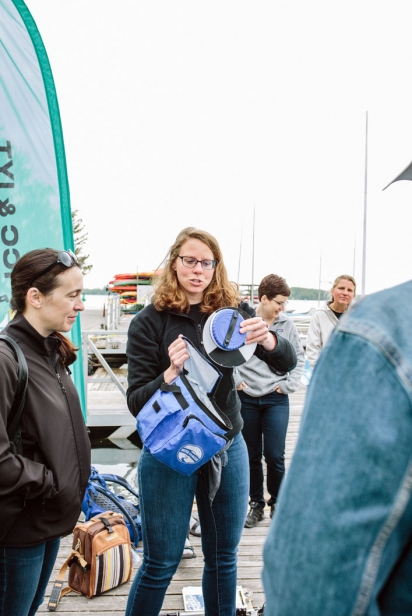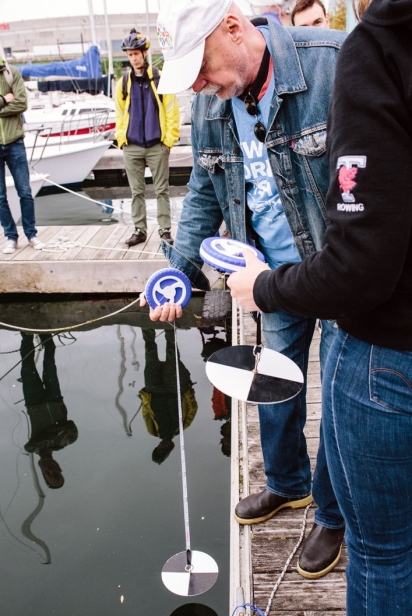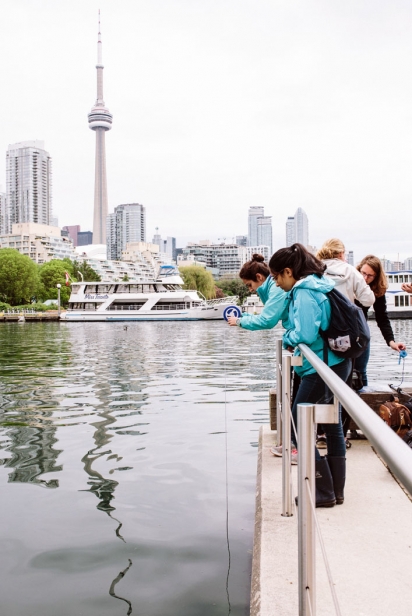Swimmable, Drinkable, Fishable Water
It’s a sunny weekend in Colombo, Sri Lanka, when Meghan Callon pays someone to drive her down to the coast. The trip is precipitated by a yearning, day in and day out at the office, for water.
The year is 2017. Callon is doing communications work with marine biologist Asha de Vos — she mostly works indoors, viewing countless videos of the ocean. (The irony, of course, is lost on no one.) Water is something Callon holds dear — she vividly recalls childhood summers spent chasing tadpoles in Sault Ste. Marie — but it crystallizes when a Sri Lankan woman bringing around refreshments notices whales on Callon’s computer screen. Pygmy blue whales live year-round along the Sri Lankan coast, but the woman didn’t know what they were. “It just showed me how easy it is to be disconnected from the water that’s right there,” Callon recounts. “The water that’s in our everyday lives.”
For Li Black, growing up in Beijing meant that water told a different story — one of conservation and scarcity. The system of water usage in her grandparents’ neighbourhood literally trickled down; water used for washing vegetables later went to washing feet, and showers, when they happened at all, were a luxury.
Everyone has a connection to water, whether they know it or not. Sheltered in the nook of a downtown Toronto café in the present day, Callon and Black are conveying exactly that with these anecdotes — what they call ‘watermarks,’ or formative stories relaying a unique, personal connection to water. They are the content specialist and information manager, respectively, of the Great Lakes Guide, an online resource produced by Toronto-based charity Swim Drink Fish, which provides comprehensive information about the lakes and what they offer, in both mental and physical sustenance, to the 40 million residents who call the Great Lakes home.
Notably, sustenance entails bringing the Great Lakes into your home — anything from hot smoked whitefish to cayenne-spiced pike chili to lake trout, baked and stuffed with apple and lemon. At its inception, the Great Lakes Guide has been a resource for historical, scientific and recreational information on the lakes, but the latest iteration encompasses food and its inextricable link to clean water and healthy communities — including an expanding collection of articles on local producers, sustainable fishing and green agricultural practices.
Food “is an extra level of connecting to the area, whether it’s wild rice you cook over your campfire or local blueberries that you find on the trail,” Callon says.
But Callon and Black are working in the service of something bigger; the Great Lakes Guide is just one of several initiatives run by Swim Drink Fish.
Since 2001, the charity has been advocating for swimmable, drinkable and fishable water by blending science, law, education and storytelling in Lake Ontario communities. Through various initiatives, which include harbour water testing, pushing local governments to implement sewage-spill alerts and real-time water monitoring, and producing resources such as the Great Lakes Guide, the organization’s goal is to empower people to protect and cultivate the relationship they have to their water bodies.
After all, the organization’s own beginnings were a result of that relationship's deterioration — when the events that transpired in Walkerton, Ont., in May 2000 brought the far-reaching impact of water on communities to the forefront. Over the course of several days, an e-coli outbreak resulted in seven deaths and more than 2,000 cases of people falling ill. Lawyer Mark Mattson and researcher Krystyn Tully met during the inquiry into the disaster. Spurred by the initial events and questions it raised about public health and responsibility, they founded Lake Ontario Waterkeeper (LOW) in 2001 to continue addressing those very questions.
The not-for-profit's early days included enforcing environmental law in the Lake Ontario watershed and developing the Swim Guide, which encompasses a community of almost three million users across eight countries. The growing number of initiatives eventually led to the creation of Swim Drink Fish, a LOW re- branding of sorts. The umbrella organization houses projects such as the Great Lakes Guide and the Watermark Project, the latter of which collects personal stories of connections to water from around the globe. “We call ourselves Swim Drink Fish because we were so tired of seeing all the signs that said ‘Don’t Swim, Don’t Drink, Don’t Fish,’” Tully says. The organization is funded primarily with donations, but has received some government money for certain initiatives.
She goes on: “The simplest way to measure the health of a community on a major scale is to just look at its relationship with water. If the water’s too polluted and some people have privileges that other people don’t, then you can pretty much guess what’s happening politically or economically. Where people do have access to clean water, they have all the opportunity in the world. Doors aren’t closed to them.”
It's important to the organization that doors remain open for everyone. Keeping the lakes clean and healthy is hardly cosmetic; for some Canadians, it represents a social safety net offering a crucial source of sustenance.
“The idea that anyone would ever go hungry when there’s literally a free food supply at the end of every north-south street is such an unsettling fact,” Tully says. “People should be able to go to the Humber River, throw a rod in, feed [their] family at no cost. That’s something that we believe fundamentally is a good thing.”
The Humber River now welcomes a burgeoning newcomer population that fishes for food on a regular basis. This act of sourcing and eating food indigenous to the region — a way of engaging actively with the Canadian terroir — speaks to a deep universality and reconnection to what the land can provide.
“One person who volunteered for us in our early days was a refugee and the Humber River was really his only food supply,” Tully recalls. “He was there every day. He would prepare little snacks with the fish that he was catching, to show this is what he would’ve eaten where he came from in his home country. That was almost 20 years ago, but I still remember.”
Even for those who don’t find themselves regularly on or near Lake Ontario, the Great Lakes still permeate every aspect of waking life — indeed, even the sleeping one. “There’s a very good chance that the electricity that powers your alarm clock comes from hydroelectric or nuclear power, both of which are hugely dependent on the Great Lakes,” Tully explains. The ways Ontarians depend on water only proliferate from there -whether it’s taking a shower, brewing coffee or putting on clothes laundered by water from the lakes.
For Toronto community monitoring co-ordinator Elise Mackie, water is ubiquitous both as a human necessity and passion -she spent many years as a competitive rower. “We called it the gap,” Mackie says, referring to the point where the inner harbour opens up. “You could see the skyline of Toronto with the sun coming over. It was just stunning.”
From May until September, Mackie trains and leads volunteers to the Toronto harbour; groups take controlled water samples on Tuesdays and Thursdays to test for alkalinity, pathogens and contaminants such as e-coli. The program — which began in 2016 — has doubled its capacity for volunteers this season. Mackie says the harbour is where volunteers see pollution’s tangible impacts: “Everyone was shocked the first time they saw a condom or a tampon applicator. This is polluted, you know. That’s when they really connect and say this is unacceptable.”
Aging infrastructure is a major problem, with much of Toronto sitting over combined sewers that mix stormwater with sewage. Ordinarily, contents in the pipes are routed to treatment facilities -but a surplus of water, particularly after big storms, will overflow directly into the lakes. And while neither tampons or condoms are things that should be flushed down a toilet, Mackie says one of the biggest obstacles in expanding that awareness comes down to public policy.
“In the larger picture, politically, there’s been a lot of pushback— even just acknowledging the fact that that’s occurring,” she says. “Any time we have a big spill, the response is always: we have a plan to fix it in 20 years. Okay, but what about now? What about that five-year-old kid and their sailboat in the inner harbour after a big storm? They need to know. Their parents need to know. So we're focused on the present time.”
What the monitoring program and Great Lakes Guide ultimately hope to achieve is improved water literacy — teaching and empowering Canadians to build a personal connection to the Great Lakes terra, from dunes and rocky cliffs to more than 130 native species of fish. Yet the increased fragility brought on by pollution and climate change are quickly diminishing the rich biodiversity of the region. “I used to be able to pull up logs and see snakes or blue salamanders. It was very connected — your toes are literally in the dirt,” Callon says. “Now there’s just nothing. To go someplace you’re so familiar with and see the little things disappearing, it’s almost scarier.”
That idyllic postcard of snakes and blue salamanders — and by extension, the image many Canadians have of their country as a place of outdoor abundance — provides a sharp contrast to the fact that Canadians spend, on average, 90 per cent of their time indoors according to Government of Canada statistics.
But being a steward of water doesn’t have to mean idling on a boat or pursuing a life in activism; Tully wants to do away with the idea that environmentalists are a certain type of person. Steps to bridging that relationship can be as simple as buying local produce or integrating more daily mindfulness about consumption.
“Maybe they’re not going to fall in love with frogs and fishes and birds,” she says. “Maybe that’s not going to be the thing that really sparks their imagination. But learning to think about how you fit into the world around you — what came before and what comes after — everyone benefits.”
Swim Drink Fish
379 Adelaide St. W., Toronto, Ont.
swimdrinkfish.ca | 416.861.1237 | @swimdrinkfish












